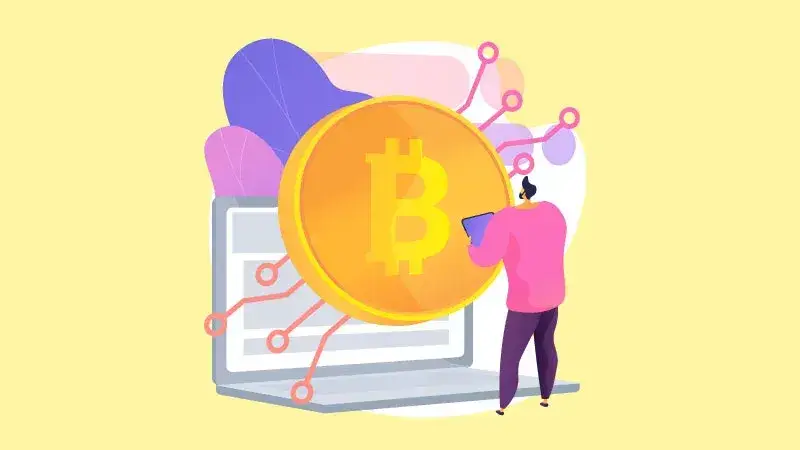What is cryptocurrency in simple terms? Simply put, it is money on the internet, but without physical coins or notes. It takes place digitally and is not controlled by a central bank or government. It sounds futuristic, but it is already a reality. It is changing the whole world, the financial system, the economy, and even everyday life. Let’s see why virtual currencies are so popular now, what is behind them, and how they work.
Why is it important to understand cryptocurrencies? How is our world changing?
Don’t think that cryptocurrencies are a fad, like everything that was once fashionable. It is changing not only the financial sector, but also global economic processes. For example, in 2023, the global cryptocurrency transaction volume was about 5 trillion US dollars. According to statistics, the cryptocurrency market will continue to grow in 2024. Cryptocurrency transactions will account for 10% of global monetary transactions.

The biggest difference between cryptocurrencies and traditional money is decentralization. It doesn’t work through a bank, but through a blockchain: a distributed database. This means that all transactions are transparent, secure, and, most importantly, instantaneous. For example, you can transfer money from one side of the world to the other in a matter of minutes, without the fees that banks charge. And for countries where access to traditional financial institutions is limited, cryptocurrencies are becoming a true revolution.
What is cryptocurrency in simple terms? Let’s analyze the concept.
When people talk about cryptocurrency, most people immediately think of Bitcoin, the first and most popular virtual currency. But in fact, this is just the beginning. Simply put, cryptocurrency is digital money that does not exist in physical form and is not controlled by a central authority. It works through a system called blockchain. This is a chain of data blocks stored on millions of computers around the world.
To understand the concept, imagine that each block is a page in a book. It records all transactions and cannot be deleted or changed. Blockchain is a kind of public ledger of all transactions, accessible to all participants in the network. But this does not mean that the data is public. It is protected by cryptographic algorithms that allow participants to remain anonymous.
How cryptocurrencies work: a look behind the scenes of the technology
To understand the details, it is necessary to know something about the business process itself. Cryptocurrencies are based on blockchain technology. It is not just a database, but a decentralized system without intermediaries. All transactions are recorded in blocks, and blocks are recorded in a chain. They are not generated and verified by a single party, but by thousands of computers.
Each participant (or node) in the network stores a complete copy of all records. It is no longer possible to change or falsify the information. Miners are responsible for verifying transactions: users make sure that the system works and receive a reward in the form of cryptocurrency. Mining is a process in which computers solve complex mathematical problems to verify the accuracy of transactions.
Types of cryptocurrencies: not all money is the same
 When we talk about virtual currencies, we usually mean Bitcoin (BTC) or Ethereum (ETH). There are actually many different types. Let’s take a look at the most popular ones:
When we talk about virtual currencies, we usually mean Bitcoin (BTC) or Ethereum (ETH). There are actually many different types. Let’s take a look at the most popular ones:
- Bitcoin (BTC) is a pioneer in the world of cryptocurrencies. It was created in 2009 by a mysterious creator named Satoshi Nakamoto. It is mainly used as a means of accumulation and investment, although it can also be used for payments.
- Ethereum (ETH) is a complete platform for creating smart contracts. It allows you to create decentralized applications (dApps) and perform complex operations such as token swaps, all without intermediaries. Many projects operate on Ethereum, including DeFi (decentralized finance).
- Litecoin (LTC) was developed as a faster and cheaper alternative to Bitcoin and is ideal for micropayments.
- Ripple (XRP) focuses on bank transfers. It is actively used for international transactions.
- Stablecoins (like USDT) are pegged to real assets, like the US dollar. This minimizes volatility, making them suitable for settling and storing funds.
How do cryptocurrencies differ from regular money?
Cryptocurrencies are not just money, as everyone knows. Regular dollars and euros are controlled by government institutions and central banks. Unlike cryptocurrencies, they are not dependent on governments or financial regulators. It is not tied to physical assets, but exists exclusively in the digital space.
How do I buy cryptocurrencies? Step-by-step instructions:
- Select a platform to buy. The most popular crypto exchanges are Binance, Coinbase, and Kraken. You can buy everything from Bitcoin to Ethereum and even more exotic coins.
- Register on the platform. In order to shop, you will need to register, fill in your details, and confirm your identity.
- Top up your account. This can be done via bank transfer, credit card, or other cryptocurrencies.
- Select the cryptocurrency you want to buy. On the platform, you will need to select the currency you want to buy.
- Make a purchase. Once the money is credited to your account, you can buy virtual currency.
- Transfer cryptocurrency to your wallet. For security reasons, it is best to store your money in a wallet rather than on an exchange.
Where to safely store cryptocurrency: an overview of the best options
When it comes to storing coins, we distinguish two main types of wallets: hot and cold wallets. Hot: always connected to the network. These options are ideal for people who make frequent transactions, as they allow you to send and receive money instantly.
Cold storage devices, on the other hand, are devices that are physically isolated from the internet. They are considered the safest, as the cryptocurrency is not at risk of being hacked via the network.
Popular cold wallets: Ledger and Trezor. They offer secure encryption and storage of private keys on physical media. For everyday use, trendy formats such as Exodus and Trust Wallet are useful. They are easy to use and support a wide range of cryptocurrencies.
When choosing, always keep the following in mind: the larger the amount, the more secure the storage method should be.

Conclusion
 Now that you understand what cryptocurrency is, how it works in short, and how it differs from traditional money, you can take action. The most important thing to remember is that this is not just another financial instrument, but part of a new economy. The sooner you start understanding the process, the sooner you will enter the future.
Now that you understand what cryptocurrency is, how it works in short, and how it differs from traditional money, you can take action. The most important thing to remember is that this is not just another financial instrument, but part of a new economy. The sooner you start understanding the process, the sooner you will enter the future.
 en
en  ru
ru  de
de  ar
ar  es
es  nl
nl  hi
hi  fr
fr  it
it  pt
pt  el
el 



